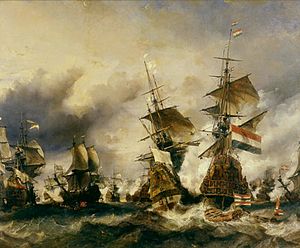Sea battle of Texel (1694)
| date | June 29, 1694 |
|---|---|
| place | in front of Texel , today's Netherlands |
| output | French victory |
| Parties to the conflict | |
|---|---|
|
|
|
| Commander | |
| Troop strength | |
| 5 frigates 2 flutes |
8 warships at least 120 merchant ships |
| losses | |
|
16 dead |
300 dead or wounded |
Palatinate War of Succession (1688–1697)
Philippsburg - Koblenz - Walcourt - Bantry Bay - Mainz - Bonn - Fleurus - Beachy Head - Boyne - Staffarda - Québec - Mons - Cuneo - Leuze - Aughrim - Barfleur / La Hougue - Namur 1 - Steenkerke - Lagos - Neerektiven - Marsaglia - Charleroi - Torroella - Camaret - Texel - Sant Esteve d'en Bas - Gerona - Dixmuyen - Namur 2 - Brussels - Ath - Cartagena - Barcelona
The Battle of Texel was a naval battle in which, as part of the War of the Palatinate Succession, on June 29, 1694, a seven-ship French naval force under Jean Bart recaptured a French convoy from a Dutch fleet under Hidde de Vries . De Vries was captured by the French but soon succumbed to his injuries. The French were able to board three of the Dutch escorts.
background
In 1692 and 1693 there were massive crop failures in France, which led to acute famine and epidemics. More than 2 million people died between 1693 and 1694. Therefore, France was dependent on grain imports in large quantities from neutral countries such as Poland , Sweden and Denmark .
On May 29, 1694 Jean Bart had instructions to sail to Norway to escort a huge fleet of 120 ships full of grain to France. However, the convoy did not wait for Bart to arrive, but set sail under the protection of three neutral warships (two Danish and one Swedish).
The battle
The convoy was soon arrested by the Dutch without firing a shot. Bart immediately went to look for the ships and finally spotted them off the Dutch island of Texel at 3 a.m. on June 29 . Although he had fewer ships and fewer cannons than the Dutch, Bart attacked Hidde de Vries' Dutch flagship, the Prins Friso , directly at 5 a.m. After a fierce battle, which lasted only about half an hour, the Prins Friso was captured and the seriously wounded de Vries captured. Two more Dutch ships were captured and the remaining five ships fled into the port. The Dutch losses amounted to 100 dead, 129 wounded and 455 prisoners.
Bart had the damage repaired on his ships and safely brought the convoy to the port of Dunkerque , where it arrived on July 3rd and was greeted by a cheering crowd celebrating their hero. Bart was invited to Versailles with his son François Cornil and his brother-in-law on July 5th , where King Louis XIV personally congratulated him. On August 4, 1694, Jean Bart was raised to the nobility. Hidde de Vries died on July 1, 1694 of his injuries.
Ships involved
France (Jean Bart)
- Maure 54 cannons (flagship)
- Fortuné 50 cannons
- Adroit 44 guns
- Jersey 50 cannons
- Comte 50 cannons
- Mignon 50 cannons
- Bienvenu 24 cannons (merchant ship)
- Portefaix 24 cannons (merchant ship)
- Biche (Corvette)
Netherlands (Hidde Sjoerds de Vries)
- Prins Friso 58 cannons (flagship) - captured by the moor
- Zeerijp 34 cannons - captured by the Fortuné
- Statenland 50 cannons - captured by the Mignon
- Amalia 58 cannons
- ? 54 cannons
- ? 50 cannons
- ? 50 cannons
- ? 40 cannons
- 120 or more merchant ships - captured sooner or later on the same day
Individual evidence
- ^ Haws / Hurst p. 335
literature
- Duncan Haws and Alexander Anthony Hurst ,: The Maritime History of the World: A Chronological Survey of Maritime Events from 5,000 BC Until the Present Day, Supplemented by Commentaries . Teredo Books, Brighton, Sussex 1985, ISBN 978-0-903662-10-9 (English).
Web links
Coordinates: 53 ° 9 ′ 0 ″ N , 4 ° 36 ′ 0 ″ E
